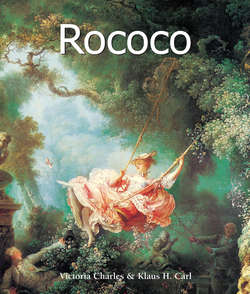Читать книгу Rococo - Victoria Charles - Страница 13
На сайте Литреса книга снята с продажи.
I. Rococo in France
François Boucher
ОглавлениеThe inclinations of this somewhat more uninhibited era were particularly to the taste of the very productive François Boucher, the favourite artist of Louis XV and one of his mistresses, Madame de Pompadour. Boucher wanted to please his contemporaries by embellishing their walls and ceilings. In this sense he embodied the taste of the century more than anyone else; he had a gift for composition, which he always expressed with a light touch, elegance and perfect harmony. As early as 1723, Boucher won the much sought-after Prix de Rome, which included a four-year stay in Rome. He was incredibly productive, creating mythological scenes with seductive goddesses, for example Diana after Bathing (1742), and pastoral scenes with alluring activities. In addition, he illustrated books and created designs for tapestries, models for porcelain figures, as well as fans and theatre decorations.
Jean-Étienne Liotard, The Chocolate Girl, c. 1744–1745.
Pastel on parchment paper, 82.5 × 52.5 cm.
Gemäldegalerie Alte Meister, Dresden.
Jean-Siméon Chardin, Saying Grace, 1744.
Oil on canvas, 49.5 × 38.4 cm.
The State Hermitage Museum, St. Petersburg.
Jean-Siméon Chardin, Girl with Racket and Shuttlecock, 1740.
Oil on canvas, 82 × 66 cm.
Galleria degli Uffizi, Florence.
Élisabeth Vigée-Le Brun, Self-Portrait at the Easel, 1790.
Oil on canvas, 100 × 81 cm.
Galleria degli Uffizi, Florence.
Jean-Baptiste Greuze, The Dead Bird, 1800.
Oil on canvas, 68 × 55 cm.
Musée du Louvre, Paris.
Jean-Siméon Chardin, The Skate, c. 1725–1726.
Oil on canvas, 114 × 146 cm.
Musée du Louvre, Paris.
As a decorative artist he was by no means inferior to his fascinating Italian contemporary Tiepolo (1696–1770). In addition he painted outstanding portraits, for example the two portraits of Madame de Pompadour of 1750 and 1759, as well as intimate domestic scenes such as the Morning Coffee or The Milliner (1746). As a painter of portraits, Boucher was always pleasing and flattering, and as a chivalrous phrasemonger, he created a world which was far removed from reality, buried under a thick layer of powder and makeup, as in his Venus in Vulcan’s Smithy (1757). He was frequently attacked by Diderot for his deceptive portrayal of a frivolous lifestyle. After the French Revolution, Boucher disappeared almost completely and was not rediscovered until the end of the 19th century.
